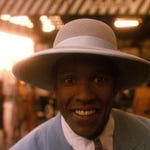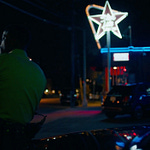Hello friends,
Here’s the first of our occasional sidebars—in this case an essay on duration in For a Few Dollars More, as a general companion to our episode on Once Upon a Time in America. If you prefer, you can choose instead to listen to this essay as a podcast, both above and on Spotify.
Thanks for your support!
—Calum
We’ve mentioned on mic the idea of “dick swinging” (or, indeed, dick measuring) in relation to long films, but with very few exceptions this is more a case of public perception than of actual authorial intent. So conditioned is the general public to spurious notions of “pretentious” and “overreaching” artists—neither of which have any real definition and are, along with “political correctness” et al., essentially propagandist coinages to better subsume free (indeed progressive) thought and practice to an avaricious machine—that a lengthy run-time in and of itself will often be looked upon with automatic suspicion. This of course applies not just to lengthy or epic work but to anything with a particular level of creative single-mindedness or distance from the conventional; that so many lengthy films will also work within a somewhat more esoteric, harder-to-grasp style, of course, only exacerbates their various reputations. In other words, it’s not that the artist has disappeared up their own arse; it’s that we can’t be arsed to engage.
At the same time, though, if a filmmaker is to dare push ahead with such an anticommercial prospect as a three-plus-hour piece (anticommercial in terms of assumed audience engagement and more literally in terms of potential screenings/ticket numbers per day), a certain level of self-belief (or, indeed, what we call “egotism”) is clearly necessary. This brings us around to our first episode’s subject, il maestro Sergio Leone, and his own experiments in what some lazy criticasters will still persist in calling “self-indulgence”—as if art isn’t by its definition an indulgence for the self.
One of my favourite sequences in all Leone comes nearly an hour into his third feature, For a Few Dollars More. The two bounty-hunting protagonists, Clint Eastwood’s taciturn Man with No Name (herein referred to as “Manco”) and Lee Van Cleef’s more dudeish, sometimes affable Col. Mortimer, finally meet, after dark in the centre of El Paso. The moment is framed, as with so many great Leone showdowns, with a reflexive sense of spectatorship: here, three young boys crawl under a building to watch proceedings and offer their own commentary. Right away, therefore, we’re conditioned to feel as if these rivals are performing something (which they are), but more deeply that the filmmakers are showing something off. Indeed, this feeling remains throughout the scene, beautifully shot by Massimo Dallamano: the ever-luxurious sense of space and composition is amped up with careful lighting, giving the heretofore diurnal film a new luminescent quality that will return later when these same characters make a tense robbery attempt. And, of course, this is one of those great scenes in which Leone shows off his ability to use silence—as important a feature of his cinema as his maverick musical collaborator Morricone.
If showmanship is ever present in Leone’s style, it’s of particular interest to this single brief sequence because the on-screen action is so uniquely tied to precisely that urge. The men size each other up in a manner familiar to fans of predecessor A Fistful of Dollars, with its climactic stand-off. But rather than working towards a gun duel—with its clear life-or-death stakes—here, the characters just peacock about for a few minutes. Eastwood scuffs Van Cleef’s shoe. Van Cleef returns the gesture. Eastwood punches him to the ground. Van Cleef stands up, dusts himself off and bends to pick up his hat—but Eastwood whips his gun out and fires, knocking the hat several metres away. Van Cleef walks patiently over to pick it up. As he bends down, Eastwood shoots the hat again, propelling it further backwards. This repeats, with its careful pacing, for three more bullets—until finally, the hat is too far away for Eastwood to hit. Van Cleef, retaining his incredible calm, now finds his moment, raising his custom-built pistol with its distinctive lengthy barrel and firing—blasting Eastwood’s hat right off his head.
Before we dive into the formal stuff, let’s just make one thing clear: this is all fucking hilarious. The biggest laff of the piece? Eastwood’s face after Van Cleef scuffs his boot:
The sequence on paper has a clear immediate narrative justification: it gets the two lead characters together for the alliance that will drive the rest of the film. But as Leone will increasingly dare to do in his films, the scene’s length with its near absurd pacing marks it out well beyond any conventional expectation. As we’ve noted with the heavy stylisation of Once Upon a Time in America, those sequences in which are explored a kind of formalised “pointlessness” seem to bear the hand of their director. They draw out simple ideas—here, two evenly-matched gunslingers finding a begrudging mutual respect—into expansive spaces of action that, were it not for the clearly rigorous visual sense, almost bear the mark of the ad lib.
It is in this sense that the hat sequence becomes a true stand-out in Leone’s brief filmography. Literally speaking, this film—the first of his westerns to exceed two hours in run time—begins the director’s increasing tendency to expansive pacing. But I love the way Manco and Mortimer’s cocksure display itself acts as a microcosm of Leone’s confident approach. Previous Leonean gunplay, as well as much subsequent Leonean gunplay, rests on the recognisable, classical drama of the duel. Opening the film is the introduction of Mortimer and his customised shooter; the aim of that scene is no more complex than a hired hand bringing in his target. Here, however, these two men, with their guns, their aim and their poise, are simply taking the time to show off to one another.
Of course, as ever with Leone matters are as much mythical as macho and this sequence is arguably one of the director’s clearest evocations of the fable mode. Its cheerfully repetitive structure reflects that adopted by countless traditional folk tales from across Europe, including those compiled from around Italy in Italian the previous decade by Italo Calvino. And, indeed, so it is that the repetition of action not only works as a character-building peacock act but also a specific process with a defined function: to bring the two characters together in a respectful alliance. It is a classic fabulist side quest.
One reason, though, that this remains arguably less straightforward than even Once Upon a Time in America is that the protagonist here—Leone’s original and archetypal “folk hero” the Man with No Name—possesses, works in and represents such a fluid moral framework. It is correct to refer to him as an “antihero”, but compare him to America’s antihero Noodles, who is our sympathetic way into the text and often a grotesque villain. This is much easier to understand, hermeneutically. But Manco, with his clearer set of foundational morals but primarily self-serving motivations, poses I think a greater set of problems in terms of identification.
Here, the character’s raison d’être keeps him largely aloof from the squabbles of the more righteous, vengeful Mortimer and the weirdly soulful, perennially stoned, villain El Indio—though all three are of course decidedly profane in their manners and goals. Manco’s status as a wandering folk hero is defined not by any specific acts of heroism or a clearly defined and constantly restated code of principles, but instead his louche libertarianism. His occasional sops to Manichean moralising swing between a kind of “bare minimum”—such as the Fistful of Dollars subplot that sees him help a perfectly innocent local family—and something more complexly personalised and arguably almost folklorist, as in his final scenes in The Good, the Bad and the Ugly where he creates an ironical and blackly comic contrivance in which shiftless rival Tuco is left with hands tied and neck noosed, balancing with increasing panic on a grave marker next to his share of the buried gold waiting to be let down.
This is only reflective, though, of how Leone portrays the growth of America into an ever more gluttonous concept far beyond its origins. Compared to its predecessor, For a Few Dollars More further foregrounds the idea of money (and the pursuit therefor), and specifically its relation to human life and the body. In A Fistful of Dollars, lives are taken as necessary or collateral damage in the pursuit of a larger and more general reward; here, there is a specific bounty directly placed on El Indio and each of his men, meaning that Manco’s goal—the full cash sum, or close to it—is one directly calculated against human lives. The very final moments of this film? Manco counting those dead men on his cart in terms of thousands.
Leone naturally doesn’t feel the need to pronounce on Manco’s motivations, even as they are ultimately balanced against Mortimer’s more personal quest to avenge his sister. The point of this complex quasi-hero is his freedom and cool—his ability to ride around as he pleases. But the amplified monetary element is an important part of the American vision that Leone conjures, and this finds its surprising echo in the hat sequence. Fancy free these awesome fellas may be, the Wild West still sits in the world of men and is still a site of greed and gain. And in its comical way the stand-off makes very clear just how much of the rough-riding bounty-hunting lifestyle is just so much business. This sequence directly echoes a previous scene in which Mortimer—watched by an amused Manco, just as the two are later watched by those three boys—faces off against Klaus Kinski’s character Wild in a saloon. Mortimer, unlit pipe in his mouth, begins the interaction by striking his match on an unsuspecting Wild, who then turns around in affront and blows out the match in punishment before reaching for his gun—only to be restrained by his compadre. Mortimer then takes Wild’s cigarillo and uses it to light his pipe, smirking as he then offers the cigarillo back to his seething rival. When Wild and gang leave, the landlord emerges from hiding beneath the bar and observes, “If the hunchback didn’t shootcha, he had a very, very important reason”. Mortimer replies, “I was thinking that myself.” For Mortimer, for Manco and for El Indio’s bandit gang, it’s all a matter of strategy, tactics, reconnaissance—business. This is a type of work, just not quite as we know it.
So it is that the mid-point hat-shooting scene finds its players engaged in an extensive exercise that the youngsters observe is “just like the games we know.” We could again use the word “pointless”, but instead keeping in mind Jacques Tati’s idea of non-productive work: a way to use the cinematic image to work through actions that deviate from any sense of clear end value. (A favourite example being the street sweeper in Mon Oncle who is often sweeping but just as often stopping to chat with passers-by, and ultimately is never seen to dispense with the various detritus he dutifully piles into the middle of the road.) In this sense the hat shoot-off between Manco and Mortimer becomes as much as anything a space of play, one in which the repetitive and seemingly obligatory macho action undertaken makes its participants something of a human assembly line—one designed primarily for the production of swagger. What value does this have? Well, none whatsoever beyond that of entertainment—and for a filmmaker with the specific political sensibilities of Leone, that’s value enough, especially in the cynical world he creates here where even the freedom of the Wild West and its opportunities for some light bounty hunting is increasingly being overtaken by systematic commodification. In his next film, with Manco re-monikered as “Blondie” and re-aligned as “the Good”, and Mortimer replaced with Van Cleef’s identical-looking “Angel Eyes” aka “the Bad”, the director will transform his Dollars-based westerns into a yet more complex and arguably more digressive format in which Eli Wallach’s oddball incursion into the Manichean split, i.e. “the Ugly”, will actually become a close point of identification.
So of course it’s not pointless: this is Leoneism boiled down to its simplest form. It is digressive and playful and speaks to a conscious re-figuring of his dearest concern, the cinematic form itself. Note how the tension in this sequence comes from the most minimalist of constructions: there is next to no progression until Eastwood’s final, failed shot. But through the wry sense of humour expressed in this absurdist repetition the director avoids mere stasis. His experiment is a success. Is this all “dick swinging”? Leone’s egotistical statement of his own genius? No; the dude’s just having a good time and hoping we’re with him.
Here we return to a key meaning behind Leone’s durationalities: their oneiric quality, by which I mean not the fantastic qualities of the dream but its ungraspability. When Leone chooses to go long—and we see this constantly throughout his longest film, Once Upon a Time in America—he does so not just with slowness but with the sense of discarded convention, the idea of stylistic pointlessness, that undergirds and defines the sequence under discussion. The Wild West is a key space, in historical as well as ongoing cultural-consciousness terms, in the developments of a dehumanising American Dream; the manifestation, as they say, of destiny. But Leone often seems to find this bleakly funny as much as anything, and the way he’ll throw comedy into the mix becomes intrinsically tied to his use of duration: that is, turning the cinematic run time into its own expansive space. In short, he gives himself room for complexity, and then the room to complicate this complexity—to keep us guessing. “On the one hand,” he was fond of explaining, “I say this; on the other, I deny it.” So it is that one of his greatest tools became duration: it gave him the space not to try and impress us, but to fuck with us. I suppose the final paradox is that for him, this was still truly serious business.



















Share this post